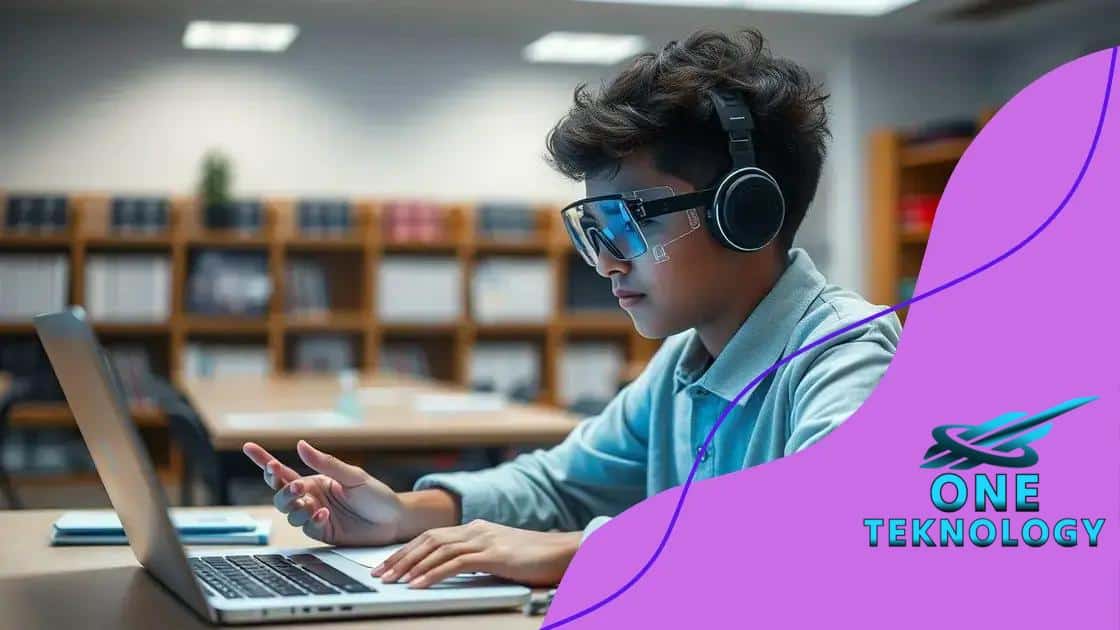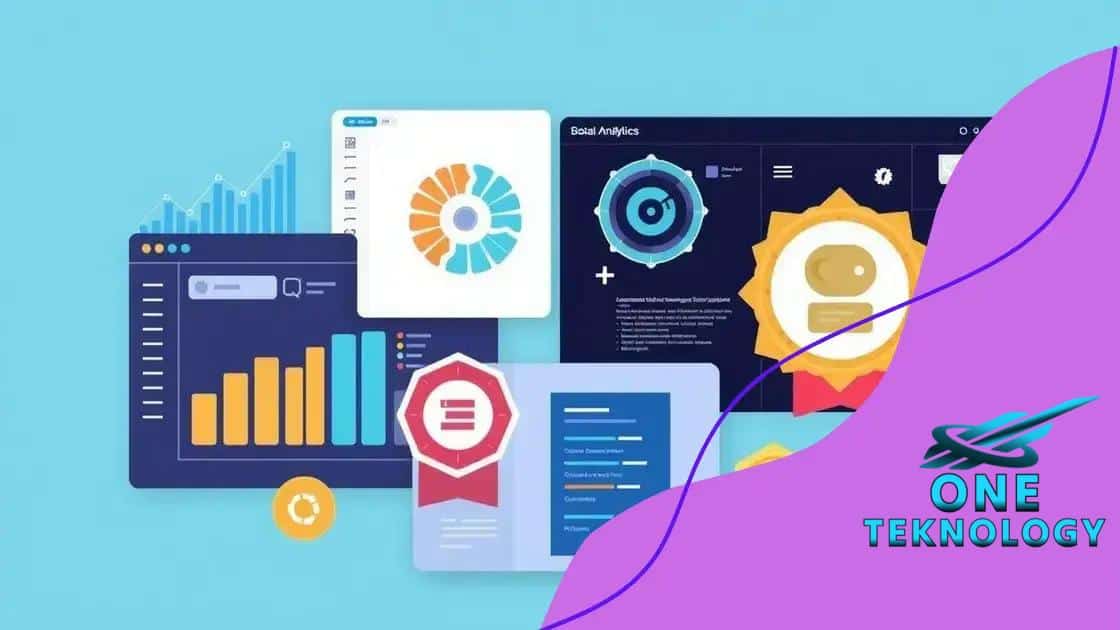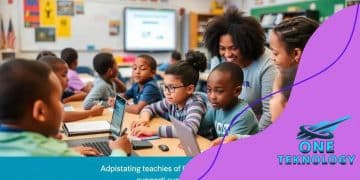The role of AI in creating personalized learning paths

The role of AI in creating personalized learning paths involves using adaptive technologies to tailor educational experiences to individual student needs, enhancing engagement and improving learning outcomes.
The role of AI in creating personalized learning paths is reshaping education as we know it. Imagine a classroom where every lesson adapts to your unique learning style. This article dives into how AI makes that a reality.
Understanding personalized learning
Understanding personalized learning is key to modern education. It focuses on tailoring learning experiences to fit each student’s unique needs, interests, and abilities. This approach empowers learners and promotes engagement.
What is Personalized Learning?
Personalized learning involves creating educational experiences that adapt to individual student preferences. Instead of a one-size-fits-all approach, educators use technology and data to customize lessons. This ensures that every student can learn at their own pace, which may lead to better outcomes.
Benefits of Personalized Learning
- Increased student engagement through tailored content
- Improved learning outcomes as students progress at their own pace
- Enhanced motivation as learners pursue topics that interest them
By identifying strengths and areas for improvement, technology helps teachers fine-tune lessons. For instance, adaptive learning software collects data on student performance, offering insights into effective strategies. This allows for targeted interventions, ensuring that no student falls behind.
Moreover, personalized learning encourages students to take ownership of their education. They can set goals and actively participate in their learning journeys. This level of involvement contributes to greater responsibility and independence.
Challenges in Personalized Learning
Despite its benefits, implementing personalized learning faces challenges. Not all teachers have the training or resources to adapt their methods effectively. Additionally, some students may struggle with more open-ended learning environments. However, with the right support and tools, these challenges can be addressed.
In practice, successful personalized learning blends technology with effective teaching strategies. Educators use assessments to gauge progress and make adjustments. This dynamic approach can cater to diverse learners, making education more inclusive.
How AI tailors educational experiences
How AI tailors educational experiences is a fascinating area in modern education. By using advanced algorithms, AI systems analyze different learning styles and preferences, allowing for more effective teaching strategies. This means that students receive content that resonates with their individual needs.
Customization Through Data
AI leverages data collected from student interactions to customize lessons. For instance, if a student struggles with a specific concept, the system can provide additional resources or adjust the difficulty of the material. This ensures that each learner has the support they need.
Interactive Learning Environments
- AI-driven platforms can adapt assignments based on performance.
- Real-time feedback helps students improve immediately.
- Gamification elements keep learners engaged and motivated.
Furthermore, AI creates interactive learning environments that are both engaging and educational. For example, virtual reality experiences can immerse students in topics like history or science, making learning feel more tangible and exciting.
With AI, teachers gain insights into student progress that were previously hard to attain. By understanding how each student learns best, educators can better support their growth. Such tools make it easier to identify which students may need extra help, thus fostering a more inclusive classroom.
The Role of Adaptive Learning Technologies
Adaptive learning technologies continuously evolve based on student input. These platforms often include assessments that help tailor the experience for each user. As a result, students can progress at a comfortable pace while mastering concepts before moving on to more complex topics.
Such systems provide a safety net, allowing students to explore content without the fear of falling behind. This innovation directly correlates with improved academic performance and greater enthusiasm for learning.
Key technologies driving personalized learning

Key technologies driving personalized learning are transforming the educational landscape. These tools create dynamic and tailored experiences for students, making learning more effective and engaging. The integration of modern technology reshapes how educators deliver content and interact with learners.
Data Analytics
One significant technology is data analytics. By collecting information about student performance, educators can identify trends and patterns. This helps in customizing learning paths based on individual progress. Teachers can focus on areas where students struggle, offering targeted resources to enhance understanding.
Artificial Intelligence
- AI-driven platforms adjust content based on learner interaction.
- They provide instant feedback to assist student comprehension.
- AI can create adaptive assessments that evolve with student needs.
Artificial Intelligence also plays a pivotal role in tailoring education. These systems analyze how students engage with materials, adjusting the pacing and difficulty of lessons. This not only helps in maintaining student interest but also ensures that learners master concepts before advancing.
Learning Management Systems (LMS)
Learning Management Systems, or LMS, are essential for implementing personalized learning. They allow educators to curate resources and track student engagement. Features like interactive quizzes and multimedia content cater to various learning styles. With an LMS, students have more control over their learning journeys.
Moreover, LMS platforms facilitate collaboration among students and instructors, encouraging a community approach to education. This interactivity can lead to richer learning experiences as students engage with their peers and share insights.
Gamification
Gamification is another driving force in personalized learning technology. By integrating game-like elements, such as points, badges, and leaderboards, educators motivate students to engage actively. This approach not only makes learning fun but also reinforces learning objectives.
As students progress, the gamified elements adapt to their achievements, creating a personalized experience. This engagement can lead to improved retention and a positive attitude towards learning.
Challenges in implementing AI in education
Challenges in implementing AI in education can be significant, even with its potential benefits. While the technology offers exciting possibilities, there are hurdles that schools and educators must navigate to make it effective.
Initial Costs
One major challenge is the initial cost of integrating AI technologies. Schools may need to invest in hardware, software, and training for staff. For many institutions, budget constraints can limit the ability to adopt these innovative tools. Without proper funding, it can be hard to acquire and maintain the necessary resources.
Training and Support
- Teachers may lack training in using AI tools effectively.
- Continuous support is necessary for successful implementation.
- Professional development programs need to be established.
Another challenge involves training educators to effectively use AI tools. Many teachers may feel overwhelmed by new technologies, leading to resistance in adopting AI systems. It is crucial to provide training and support to help them become comfortable with these tools.
Furthermore, the lack of consistent support can lead to underutilization of AI resources. Schools should ensure that educators have access to ongoing professional development. This can empower them to integrate AI into their lesson plans, ensuring that students benefit fully.
Data Privacy Concerns
Data privacy is another significant concern when implementing AI in education. Collecting and analyzing student data raises questions about how that information is stored and used. Parents and educators alike want assurance that student privacy is maintained. Schools must establish clear policies to protect student information while taking advantage of AI’s capabilities.
Additionally, there can be ethical considerations surrounding AI use in education. It is vital to ensure that algorithms do not reinforce biases or discriminate against certain groups. Educators must remain vigilant in evaluating AI tools to ensure they promote fairness and equity.
Future trends in AI and personalized learning paths
Future trends in AI and personalized learning paths are shaping the educational landscape as technology continues to evolve. These trends highlight how AI can enhance learning experiences while meeting the unique needs of each student.
Increased Use of Adaptive Learning Systems
One key trend is the growth of adaptive learning systems. These systems use AI to adjust lessons based on a student’s performance and preferences. As they engage with content, these systems learn which methods are most effective for each learner. This capability allows for a highly personalized educational experience tailored to individual strengths and weaknesses.
Integration of Learning Analytics
- Learning analytics helps track student progress.
- Data-driven insights improve teaching strategies.
- Educators can identify at-risk students early.
Another significant trend is the integration of learning analytics, which provides data-driven insights into student progress. By analyzing this data, teachers can refine their strategies and ensure that every student is on the right track. They can easily identify at-risk students and implement targeted support to help them succeed.
Moreover, learning analytics fosters a more collaborative environment between teachers and students. As students take ownership of their learning, they can use the insights from analytics to understand their progress and areas for improvement.
Enhanced Engagement Through Gamification
Future AI systems will also likely incorporate more gamification elements. By including game-like features such as rewards, challenges, and interactive scenarios, schools can enhance student motivation. When learning feels like a game, students are more likely to engage with the content deeply.
As educators utilize gamification in AI-driven platforms, they can create an environment where students feel excited to learn. This not only boosts engagement but also encourages collaboration and creativity among peers.
Greater Personalization with AI
The future of personalized learning will see even greater levels of customization. Innovations in AI technology will enable educators to offer more individualized pathways for students. This may include personalized resources, customized assessments, and tailored assignments that focus specifically on each student’s interests and needs.
As AI continues to advance, the potential for personalized learning is limitless. Students will benefit from a dynamic educational experience that evolves with them, ensuring they receive the support and challenges that facilitate their growth.
FAQ – Frequently Asked Questions about AI in Personalized Learning Paths
How does AI personalize learning for students?
AI analyzes individual student data to tailor educational experiences, adjusting content and pacing to fit each learner’s needs.
What are the benefits of using gamification in education?
Gamification increases student engagement and motivation by incorporating game-like elements, making learning more enjoyable and interactive.
What role do learning analytics play in education?
Learning analytics provide insights into student performance, helping educators identify areas where students need further support and improving overall learning outcomes.
What challenges might schools face when implementing AI?
Schools may encounter challenges such as high initial costs, the need for teacher training, and concerns about data privacy.






